If you’re into outdoor adventures, waterproofing your backpack will keep all your gear dry and safe.
You can apply a waterproof spray or use drybags to protect your backpack from the rain.
Although you can predict the weather in advance, the rain might surprise you all of a sudden, so you need to be prepared.
In this article, you’ll learn how to waterproof a backpack using several products that you can easily access before or after you leave home.
Here are the best ways to waterproof a backpack:
1. Use Waterproof Spray
This is one of the easiest and least expensive methods to waterproof your backpack.
You can buy an affordable waterproof spray and coat your backpack to make sure that it will be water-resistant.
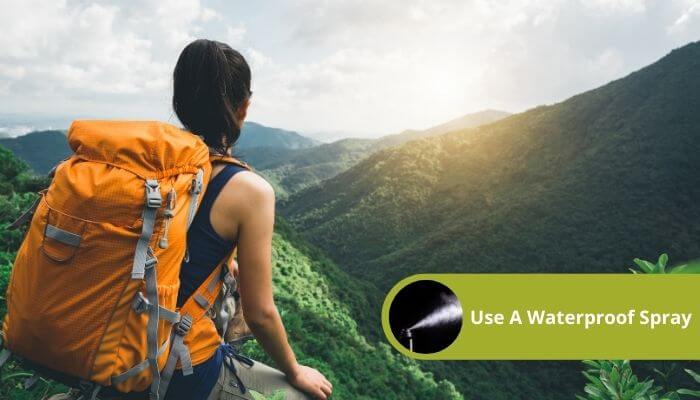
In most cases, one can of spray will be enough to cover the backpack.
Most people overlook this method because it’s simple, but this is why it’s incredibly successful.
It will be perfect if you’re spending time away from home, as it can protect your gear from the dew and mist.
However, you might need to do more to make sure that the seams are perfectly sealed.
Using a seam sealant is a great way to waterproof any zippers.
You can apply a second layer of this spray while you’re away from home. It helps the moisture slide off the body of the backpack, away from your electronic gadgets and other outdoor gear.
If you’re going kayaking or rafting, this method won’t work for you.
It won’t protect your gear if your backpack is submerged in water as it doesn’t provide enough protection.
Be aware the effects of waterproof spray won’t last forever so if your backpack gets a lot of use you may need to reapply the spray annually.
Pros:
- Easy and cheap.
- Keeps the outer surface of the backpack dry.
- You can reapply the spray as needed.
Cons:
- Doesn’t protect the seams of the backpack.
- If the backpack gets submerged in water, the contents will get wet.
2. Use a Garbage Bag
This is one of the cheapest ways to waterproof your backpack which guarantees that all your belongings will stay dry.
All you have to do is to spread a garbage bag and cut it open, then use the material to line your backpack and stick it using tape.
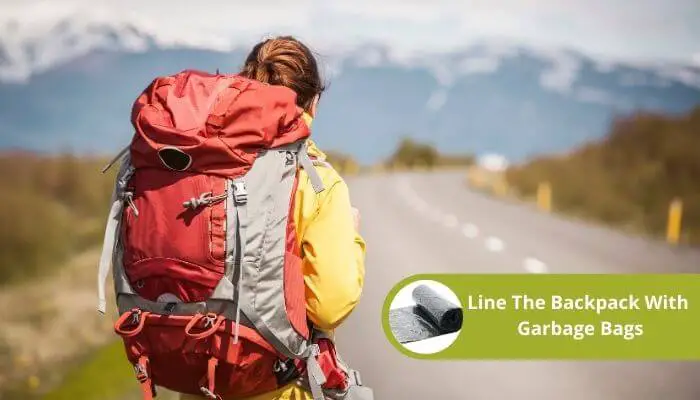
You can wrap your gear in garbage bags for better insulation or put them all inside a big plastic garbage bag before packing them inside your backpack.
This means that even if it suddenly rains and your backpack allows the water to pass through, the contents will stay dry and protected.
Before you go on an outdoor trip, make sure that you have extra garbage bags for emergencies.
They’re straightforward to use and can be customized, as you can cut the material based on your needs.
In most cases, you’ll have to add more garbage bags because the material can easily get cut while you’re removing your gear or putting items into the backpack.
Nevertheless, this method means that the backpack’s outer surface will get wet, so you need to make sure that you’re not keeping any tools or gadgets in the outside pockets.
You might also spend a lot of time making sure that every inch of your backpack interior is adequately lined.
Pros:
- Easy and cheap.
- You can add more if the weather gets worse.
- Works for multiple sizes and types of backpacks.
Cons:
- Doesn’t work in case the backpack gets submerged in water.
- It’s a bit difficult to get a tight fit or lining that covers every inch of the backpack.
- The outer surface of the backpack will get wet.
3. Use a Backpack Liner
Made of thin yet durable and waterproof material, a rucksack liner will help you keep all your tools dry and safe.
It also provides adequate protection if the backpack accidentally rips.
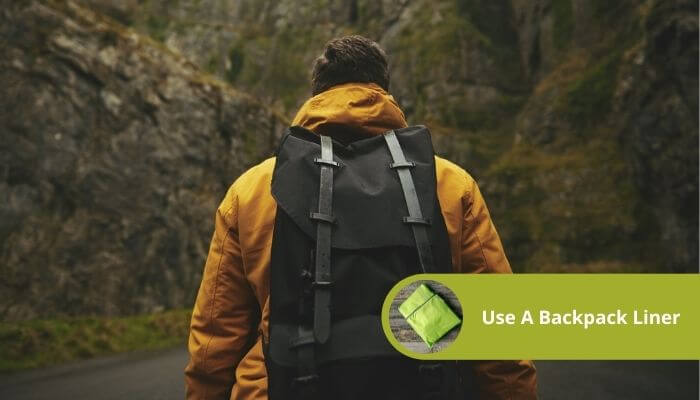
You can put your items inside the rucksack liner and tighten the band to protect your gear from the water.
If you’re kayaking or rafting, this method will help protect the contents in case your backpack gets submerged in water.
It also provides some cushioning in case you accidentally drop your backpack while hiking or mountain climbing.
Pros:
- Durable and lightweight.
- Adequate protection if the backpack gets submerged.
Cons:
- More expensive than other methods.
4. Use a Rain Cover
A rain cover can be easily kept in a zipped pocket and used when it starts pouring.
The cover is designed to cover your backpack and protect it from the water.
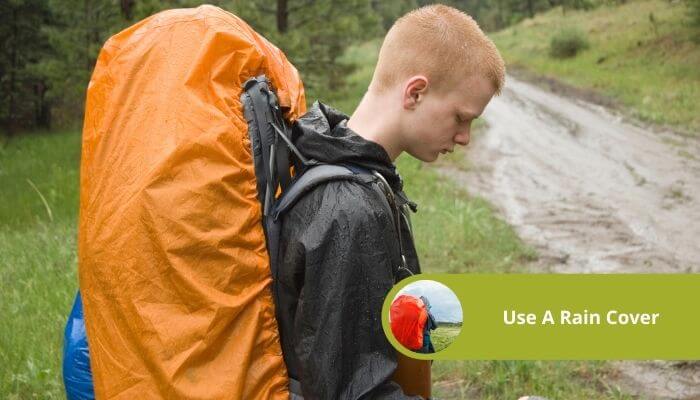
This cover is made of thin yet waterproof material and is quickly used to cover your backpack.
An elastic band will keep it in place, and you can remove it once the rain is over.
Moreover, if you choose a bright rain cover, it will provide better visibility at night.
Car drivers will be able to spot you, and you can easily spot your backpack in low-light conditions.
If you’re going hiking or mountain climbing, keeping this rain cover in an accessible pocket will be an excellent decision.
However, since it doesn’t cover the backpack completely, it’s not suitable for rafting, river trekking, or rafting.
Pros:
- Easy to apply and remove.
- Doesn’t occupy much space in your backpack.
Cons:
- Doesn’t protect the contents of the backpack if it gets submerged in water.
5. Use an Old Raincoat
If you have an old raincoat or poncho that you don’t wear anymore because it got torn or damaged, you can recycle it to keep your gear dry and safe.
A raincoat is made of waterproof and durable material, so you will be able to enhance the waterproof properties of your backpack without spending extra money.

All you have to do is to cut open a raincoat or poncho and use the material to adequately line your backpack.
Use tape or even sew the material to the interior lining of the backpack to make sure that it doesn’t move.
Although the outer surface of the backpack might let the water pass through, the gear inside your backpack will be perfectly protected.
However, this method doesn’t work if your backpack gets submerged in water.
Pros:
- Easy and cheap.
- Doesn’t occupy much space in your backpack.
Cons:
- Doesn’t work if your backpack gets submerged.
- The outer surface of the backpack will get wet.
6. Use a Dry Bag
A dry bag is waterproof and can completely cover your backpack if needed
It’s also abrasion-resistant to provide adequate protection in the most extreme conditions.
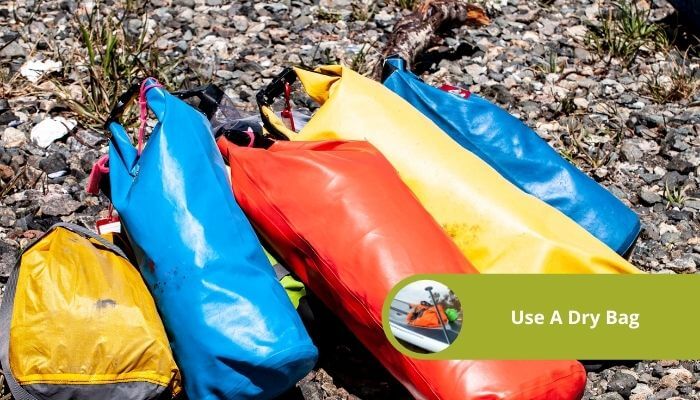
There are different sizes of dry bags available on the market, so you can easily find one that fits your backpack conveniently.
If you’re engaging in an activity where your backpack is likely to get extremely wet, this will be the right choice for you.
Rafters, swimmers, boaters, and kayakers should invest in a dry bag because it provides adequate protection, even if your backpack gets accidentally submerged in water.
However, some people think about holding their stuff in a dry bag instead of carrying an actual backpack.
Although this dry bag will keep your gear dry, it’s not the most accessible option when you’re away from home.
It’s usually made of a single compartment, so you might not be able to find all your tools when you need them.
A backpack usually features several pockets and compartments to keep your tools perfectly organized.
Pros:
- Several types are available.
- Works in case of heavy rain.
- Keeps the backpack dry even if it gets submerged.
Cons:
- More expensive than other methods.
7. Use Ziploc Bags
This method can be combined with any of the previous ones to protect valuable gadgets and tools before heading on an outdoor adventure.
Some devices and tools are extremely sensitive, and the slightest amount of water can damage them.
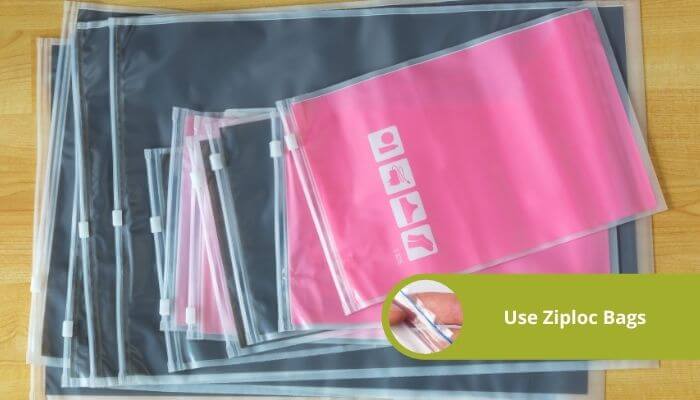
Ziploc bags work well as waterproof cases and they are affordable and easy to use.
The Ziploc bag is squeezed to keep the air out and protect any tool or gadget because it’s made of thick material.
Even if you’re carrying a belt bag while hiking or jogging, a Ziploc bag will keep your phone or camera safe and dry when it suddenly starts to rain.
When you’re camping for several days, Ziploc bags will be perfect for storing your food.
The dryness will guarantee that your food will stay fresh and delicious until you’re hungry. However, if your backpack will be submerged in water, this method won’t be 100% effective.
Pros:
- Protects expensive tools and gadgets.
- Affordable and easy to use.
- Works if you’re carrying a belt bag.
Cons:
- Should be combined with other methods to provide adequate protection.
- Doesn’t work if the backpack gets submerged in water.
Also Read: Are Kankens Waterproof?
Summary
Before heading on your next outdoor adventure, make a few adjustments to your current backpack to guarantee that your tools, gear, and gadgets will stay dry.
Even if your backpack gets submerged in water, you can keep your tools safe.
You can use one or combine several methods together, depending on your needs.
If you’re going hiking or expect some rain showers, you can get away with applying a waterproof spray or lining the interior of your backpack.
However, if you’re engaging in an activity where your backpack is likely to get submerged in water, you should invest in a rucksack liner or a dry bag to make sure that your backpack will stay dry.
